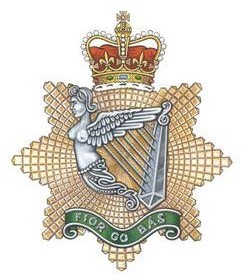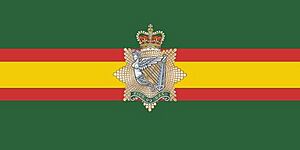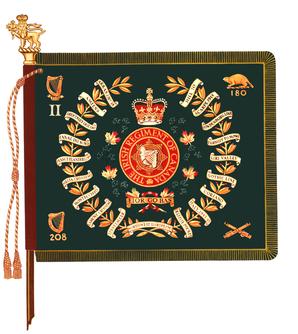Irish Regiment of Canada facts for kids
Quick facts for kids Irish Regiment of Canada |
|
|---|---|

Regimental badge
|
|
| Active | 1915–present |
| Country | Canada |
| Branch | Canadian Army |
| Type | Kilted Irish infantry |
| Role | Infantry |
| Size | One battalion |
| Part of | 33 Canadian Brigade Group |
| Garrison/HQ | Sudbury, Ontario |
| Motto(s) | Irish: Fíor go bás, lit. 'Faithful until death' |
| March | "Garry Owen" |
| Insignia | |
| Headdress | Caubeen |
| Tartan | O'Saffron |
The 2nd Battalion, Irish Regiment of Canada is a special part-time army unit. It is an infantry regiment, meaning its soldiers fight on foot. This unit is part of the Canadian Army and is located in Sudbury, Ontario. It belongs to the 4th Canadian Division's 33 Canadian Brigade Group.
The Irish Regiment was first started in 1915 in Toronto. The unit we know today in Sudbury was formed in 1965. It was created when an artillery unit (soldiers who use big guns) called the 58th Field Artillery Regiment became an infantry unit. At the same time, the original Toronto unit was closed down.
In 1931, the Irish Regiment of Canada became the only Irish regiment in the world to wear kilts! They adopted a special tartan (a patterned fabric) called "O'Saffron." Other Irish regiments in the British Army have pipers who wear solid-coloured saffron kilts, but the Canadian Irish Regiment wears a unique patterned one. They also wear a special cap called a caubeen, which is common among other Irish regiments.
Contents
History of the Regiment
The Irish Regiment of Canada has a long history, starting in 1915. Over the years, its name and role have changed several times. It has also joined with other military units to become what it is today.
How the Irish Regiment of Canada Began
- It started on October 15, 1915, in Toronto, Ontario, as an "infantry regiment."
- It was called the 110th Irish Regiment in 1916.
- Later, it became simply the Irish Regiment, and then the Irish Regiment of Canada.
- In 1936, it joined with part of the 1st Machine Gun Battalion.
- In 1965, the unit in Toronto was closed. The 58th (Sudbury) Field Artillery Regiment became the 2nd Battalion, the Irish Regiment of Canada (Sudbury).
Other Units That Joined
Over time, several other units became part of the Irish Regiment of Canada. These include:
- The 1st Machine Gun Battalion, which started in 1919.
- The 58th (Sudbury) Field Artillery Regiment, which began in 1946 as an anti-aircraft unit.
- The 173rd Field Battery, RCA, which started in 1920.
- The 174th Field Battery, RCA.
- The 175th Field Battery, RCA, which also started in 1920.
All these units eventually combined to form the Irish Regiment of Canada as it is known today.
Units Remembered
The Irish Regiment of Canada also "perpetuates" or remembers the history of several units from the First World War. This means they carry on the traditions and honours of these older units.
From the First World War
- 180th Battalion (Sportsmen), CEF
- 208th Battalion (Canadian Irish), CEF
- 1st Battalion, Canadian Machine Gun Corps, CEF
- 30th Field Battery, Canadian Field Artillery, CEF
- 53rd Field Battery, CFA, CEF
What the Regiment Has Done
The Irish Regiment of Canada has played a part in major conflicts throughout history.
The First World War
During the First World War, several battalions that are now part of the Irish Regiment helped in the war effort.
- The 180th Battalion (Sportsmen), CEF went to Great Britain in 1916. Its soldiers then joined other Canadian units fighting in France.
- The 208th Battalion (Canadian Irish), CEF also went to Great Britain in 1917. Its soldiers helped reinforce Canadian troops on the front lines.
- The 1st Battalion, CMGC, CEF, provided machine gun support to Canadian soldiers in France.
- The 30th Field Battery, CFA, CEF, and the 53rd Field Battery, CFA, CEF, provided artillery support (using big guns) in France and Flanders.
The Second World War
The regiment played an important role in the Second World War.
- On September 1, 1939, the Irish Regiment of Canada (Machine Gun) was called to active duty for local protection.
- On May 24, 1940, the main unit, called the 1st Battalion, The Irish Regiment of Canada, was sent overseas.
- They arrived in Great Britain in 1942.
- In November 1943, they landed in Italy as part of the 5th Canadian Armoured Division. They fought in Italy until February 1945.
- Then, they moved to North-West Europe as part of Operation Goldflake and continued fighting until the war ended.
- The 53rd Field Battery also served in the war, providing anti-aircraft support in Great Britain.
Afghanistan
The regiment also sent many of its soldiers to Afghanistan between 2002 and 2014. More than 20% of its members served in different task forces there.
Battle Honours
Battle honours are special awards given to military units for their bravery and success in battles. The Irish Regiment of Canada has earned many of these honours. The ones in bold are displayed on the regiment's flag.
- Arras, 1917, '18
- Hill 70
- Ypres, 1917
- Amiens
- Scarpe, 1918
- Drocourt–Quéant
- Hindenburg Line
- Canal du Nord
- Pursuit to Mons
- France and Flanders, 1917–18
- Liri Valley
- Melfa Crossing
- Gothic Line
- Montecchio
- Coriano
- Lamone Crossing
- Fosso Munio
- Conventello–Comacchio
- Italy, 1943–1945
- IJsselmeer
- Delfzijl Pocket
- North-West Europe, 1945
- Afghanistan
Alliances
The Irish Regiment of Canada has a special connection with another military unit:
 United Kingdom - The Royal Irish Regiment (27th (Inniskilling) 83rd, 87th and Ulster Defence Regiment) (a regiment in the United Kingdom)
United Kingdom - The Royal Irish Regiment (27th (Inniskilling) 83rd, 87th and Ulster Defence Regiment) (a regiment in the United Kingdom)
Irish Regiment of Canada Regimental Museum
| Location | Sudbury Armoury, 333 Riverside Drive, Sudbury, Ontario, Canada |
|---|---|
| Type | Regimental Museum |
The Irish Regiment of Canada Regimental Museum is a place where you can see cool items from the regiment's history. It has memorabilia (things that remind you of the past) from the First World War and beyond. This includes items from United Nations operations and peacekeeping missions. The museum helps teach people in Northern Ontario about the Canadian Forces. It especially highlights the local army reserve units and why they are important.
Media
- The Story of the Irish Regiment of Canada 1939-1945 by Major Gordon Wood



